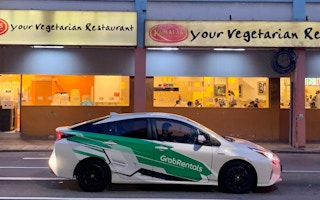Grab, Southeast Asia’s largest ride-hailing app, faces a classic problem for a still-young company trying to reduce its carbon footprint — how to decarbonise a business that is in rapid expansion mode?
To continue reading, subscribe to Eco‑Business.
There's something for everyone. We offer a range of subscription plans.
- Access our stories and receive our Insights Weekly newsletter with the free EB Member plan.
- Unlock unlimited access to our content and archive with EB Circle.
- Publish your content with EB Premium.
This is a particularly tricky problem for a company like Grab, whose core business relies on petrol-powered vehicles to ferry a growing number of people around a developmentally diverse region. Renewable energy capacity and electric vehicle (EV) charging infrastructure are still nascent in most Southeast Asian countries.
Grab has just published its latest environment, social and governance (ESG) report, in which it pledged to be a carbon neutral company by 2040. Carbon neutrality can be achieved by buying carbon credits equivalent to the company’s emissions, without reducing them. Grab had initially looked into cutting its emissions to net-zero, using science-based targets to reduce the firm’s emissions in line with the Paris Agreement goal of capping global warming below 2°C. But given Grab’s “hyper-growth” trajectory, achieving net-zero was not feasible, says Iris Chang, the firm’s head of sustainability.
“
We didn’t want to come up with a decarbonisation target for vanity’s sake.
Iris Chang, head of sustainability, Grab
The “everyday, everything” app, whose services include food delivery, online shopping and financial services, is projected to grow gross merchandise value — the total amount of sales via its platform — by 40 per cent a year, as it enters more cities, recruits more drivers, and on-boards more merchant partners. Grab added 680,000 new merchants to the platform in 2021, 13 per cent growth over previous the year. Revenue grew by 44 per cent, partly off the back of strong growth in deliveries.
This growth comes with a big carbon cost. Though the company does not reveal its projected emissions, Grab calculates that its carbon footprint was 1.5 million tonnes of carbon dioxide equivalent in 2021. Reducing this climate impact is not easy, since 96 per cent of the firm’s emissions come from vehicles booked through the app, which it does not own.
The company plans to limit its emissions by attempting to electrify the 2.8 million vehicles used on the app, running its operations on renewable energy, and investing in carbon removal programmes. Electrifying its fleet without penalising its drivers will be the biggest challenge, says Chang. A 2021 study found that the high relative cost of EVs in Southeast Asia was the biggest barrier to adoption.

Iris Chang, head of sustainability, Grab. Image: LinkedIn
“We didn’t want to set a [decarbonisation] goal that was unattainable, and would affect the ability of our drivers to earn a living,” says Chang. A lack of infrastructure is also applying the brakes to Southeast Asia’s young EV ecosystem. “It’s a chicken-and-egg situation,” says the former marketer, who after five years with the company took the top sustainability job in 2021. “Governments won’t build infrastructure if there are no EVs on the road, and drivers won’t buy EVs if there’s no infrastructure.”
Grab is working with governments on ways to roll-out charging infrastructure faster and bring down the cost of EVs for drivers. But the company’s sustainability mandate is not made any easier by Grab’s financial situation. The Singapore-headquartered firm, which has yet to turn a profit over its 10-year history, reported a US$3.6 billion full-year loss in March, partly a result of dishing out incentives to attract drivers and aggressively promoting its food delivery business.
In this interview, Chang talks about the challenge in setting Grab’s climate target, the company’s role in driving transport electrification in Southeast Asia, and why the sustainability team sits in the marketing department.
How did you go about setting Grab’s decarbonisation target? How long did it take?
It took us about a year and a half to put the decarbonisation target together. We started off inventorising the carbon in the business — which in itself is a long process, collecting data and articulating what it means. Then we consulted experts in the field, including World Wide Fund for Nature (WWF), World Resources Institute (WRI), and CDP, and brought in ENGIE Impact, a consultancy that specialises in decarbonisation. We also spoke to a lot of people internally, and modelled our target against our projected business growth.
We were very clear from day one that we didn’t want to come up with a decarbonisation target for vanity’s sake. We wanted a goal that we could move forward with in this region, which is very challenging [for companies looking to reduce emissions]. After we valuated our emissions with the Science Based Targets Initiative [a framework that helps companies reduce emissions in line with the Paris Agreement goals], we realised that because of our projected growth, it wasn’t going to be realistic. So we worked out the next best thing we could do.
How easy was it getting management buy-in to decarbonise Grab?
To be honest, it wasn’t very difficult. It took a couple of executive committee meetings. Everybody in our management team is well aware that climate change will have adverse effects on our community’s wellbeing and livelihoods. A key consideration for setting the goals was the needs and challenges of our drivers. We didn’t want to set a goal that was unattainable, and would affect the ability of our drivers to earn a living.
Grab’s decarbonisation target is not aligned with the Paris Agreement. Was there a sense that the target could have been more ambitious?
We wanted the target to be science-based, but our business is projected to go through a hyper-growth phase. In addition, more than 96 per cent of our emissions — our Scope 3 emissions — come from the vehicles owned and operated by drivers and partners. It is very, very challenging for us just to achieve carbon neutrality. If we were to shorten the timeframe [and achieve carbon neutrality earlier], I don’t know how sustainable it would be for our driver partners — that’s the big question mark. Southeast Asia is still at the early stage for EV adoption, and price parity [versus petrol cars] is not expected for the next five or 10 years.
“
I can’t say to Anthony [Tan, Grab’s co-founder and chief executive], ‘can we stop growing?’
Innovation in batteries and the availability of charging stations are other limiting factors. An EV has to be a convenient option for drivers. We really thought long and hard about these targets. We wanted to make sure they are inclusive.
What’s the hardest thing about decarbonising Grab?
Not being in control of the [EV] ecosystem. We don’t have control over countries’ electricity grids and policies, which vary greatly across Southeast Asia. And although we are actively partnering with the governments [in eight markets] to shape some of the thinking in the transportation industry, it is still a challenge. Where we are in control of the process, for instance energy usage, we are on top of things — as of last year, we use 100 per cent renewable energy across our 12 corporate offices globally.
Can’t Grab pursue slower growth, so that you can achieve more ambitious sustainability targets?
We are a marketplace that in order to be efficient, we need to achieve scale. I can’t say to Anthony [Tan, co-founder and chief executive] ‘can we stop growing?’ because we are not at that point of efficiencies yet. In order for the business to make positive impact, the business needs to be financially sustainable.
How have Grab’s financial difficulties affected securing budget for sustainability programmes?
Grab wants to become a triple bottom line company, which means that we take environmental impact into consideration in everything we do. Our mission is to empower everyone to earn a living, and the environment has a negative impact on that mission. So it’s not as challenging as you might think to get the resources I need, because achieving our mission depends on sustainability. However, we do need to be mindful of the best times to spend on sustainability programmes; is it a small pilot that might eventually scale, or is it a project that will have a huge impact that requires funding right now?
How are you working to make EVs more affordable for drivers?
In every country, we are thinking about how to build an inclusive EV ecosystem. But it’s a chicken-and-egg situation. Governments won’t build infrastructure if there are no EVs on the road, and drivers won’t buy EVs if there’s no infrastructure. In Thailand, we have just partnered with [finance group] Kasikorn Leasing and [EV manufacturer] MG to promote an EV loan programme, which gives drivers cheaper rates for EVs.
Where we can, we want to shape and influence the system to build a stronger case for drivers to use EVs. We can educate our drivers, and we can shift some of the demand towards EV use among consumers. And we engage with regulators to see how we can support them, whether that’s with data [Grab’s data can inform urban planners where the most in-demand places to locate EV charging stations are] or pilots that we’ve already run in other countries.
How confident are you that governments are moving quickly enough to set up the infrastructure needed for EVs at scale?
We have to look at opportunities where Grab can come in and partner [governments]. The EV ecosystem [in Southeast Asia] will take time to mature, but we are not going to sit and wait — we want to take action now. Which is why we’re working on partnerships and running pilots, so that when a country moves forward, we can use what we’ve learned to drive scale.
For most of your career, you’ve been a marketer. How difficult has it been to switch to sustainability?
Skills are transferable. A marketer’s skill is to be able to really understand the problems that people are facing, shift perceptions and change behaviour. I’ve been in marketing for 12 years, and I think these skills translate to a sustainability role where I need to be able to push for transformation in an organisation like Grab. I need to be able to understand the struggles of our drivers and what consumers think about environmental and social issues, as consumer sentiment could pose a risk to the business.
When I took on the sustainability role, there were many things I needed to learn. Before setting a carbon target, I needed to speak with industry experts. I went on training programmes and became GRI [Global Reporting Initiative, a sustainability reporting framework] certified. I also had to hire well, and put a lot of faith in specialists.
Why does Grab’s sustainability team sit in the marketing team? One theory for how to spot greenwash is to see if the sustainability team sits in the communications or marketing department…
First, I would say that you need to be very clear as a business what your core mission is, and how it aligns with ESG goals. If there is a mismatch then whatever you say as a brand confuses your identity. A lot of our social impact and environmental initiatives have been driven from the ground up, because our marketers have been perceptive to the needs of our drivers and consumers. I lobbied for the no-cultery toggle [which enables users opt out of plastic cutlery]. We didn’t do a huge marketing campaign behind it, but it had a big impact — consumers really value the feature. That’s when I decided that I was ready to let go of marketing and do sustainability 100 per cent of my time. It’s been so worth it.

















